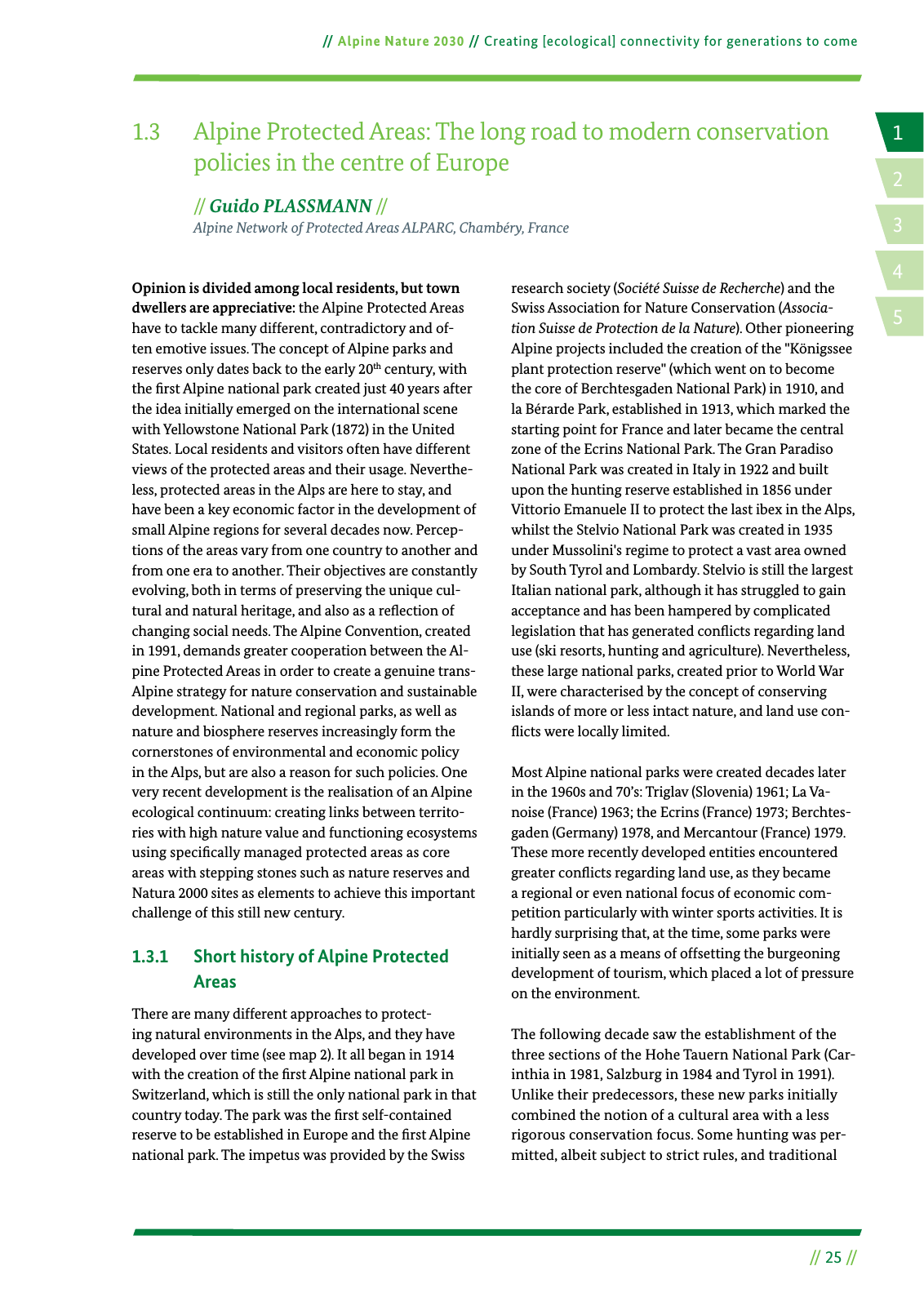14 2 5 3 25 Alpine Nature 2030 Creating ecological connectivity for generations to come 1 3 Alpine Protected Areas The long road to modern conservation policies in the centre of Europe Guido PLASSMANN Alpine Network of Protected Areas ALPARC Chambéry France Opinion is divided among local residents but town dwellers are appreciative the Alpine Protected Areas have to tackle many different contradictory and of ten emotive issues The concept of Alpine parks and reserves only dates back to the early 20th century with the rst Alpine national park created just 40 years after the idea initially emerged on the international scene with Yellowstone National Park 1872 in the United States Local residents and visitors often have different views of the protected areas and their usage Neverthe less protected areas in the Alps are here to stay and have been a key economic factor in the development of small Alpine regions for several decades now Percep tions of the areas vary from one country to another and from one era to another Their objectives are constantly evolving both in terms of preserving the unique cul tural and natural heritage and also as a re ection of changing social needs The Alpine Convention created in 1991 demands greater cooperation between the Al pine Protected Areas in order to create a genuine trans Alpine strategy for nature conservation and sustainable development National and regional parks as well as nature and biosphere reserves increasingly form the cornerstones of environmental and economic policy in the Alps but are also a reason for such policies One very recent development is the realisation of an Alpine ecological continuum creating links between territo ries with high nature value and functioning ecosystems using speci cally managed protected areas as core areas with stepping stones such as nature reserves and Natura 2000 sites as elements to achieve this important challenge of this still new century 1 3 1 Short history of Alpine Protected Areas There are many different approaches to protect ing natural environments in the Alps and they have developed over time see map 2 It all began in 1914 with the creation of the rst Alpine national park in Switzerland which is still the only national park in that country today The park was the rst self contained reserve to be established in Europe and the rst Alpine national park The impetus was provided by the Swiss research society Société Suisse de Recherche and the Swiss Association for Nature Conservation Associa tion Suisse de Protection de la Nature Other pioneering Alpine projects included the creation of the Königssee plant protection reserve which went on to become the core of Berchtesgaden National Park in 1910 and la Bérarde Park established in 1913 which marked the starting point for France and later became the central zone of the Ecrins National Park The Gran Paradiso National Park was created in Italy in 1922 and built upon the hunting reserve established in 1856 under Vittorio Emanuele II to protect the last ibex in the Alps whilst the Stelvio National Park was created in 1935 under Mussolini s regime to protect a vast area owned by South Tyrol and Lombardy Stelvio is still the largest Italian national park although it has struggled to gain acceptance and has been hampered by complicated legislation that has generated con icts regarding land use ski resorts hunting and agriculture Nevertheless these large national parks created prior to World War II were characterised by the concept of conserving islands of more or less intact nature and land use con icts were locally limited Most Alpine national parks were created decades later in the 1960s and 70 s Triglav Slovenia 1961 La Va noise France 1963 the Ecrins France 1973 Berchtes gaden Germany 1978 and Mercantour France 1979 These more recently developed entities encountered greater con icts regarding land use as they became a regional or even national focus of economic com petition particularly with winter sports activities It is hardly surprising that at the time some parks were initially seen as a means of offsetting the burgeoning development of tourism which placed a lot of pressure on the environment The following decade saw the establishment of the three sections of the Hohe Tauern National Park Car inthia in 1981 Salzburg in 1984 and Tyrol in 1991 Unlike their predecessors these new parks initially combined the notion of a cultural area with a less rigorous conservation focus Some hunting was per mitted albeit subject to strict rules and traditional

Hinweis: Dies ist eine maschinenlesbare No-Flash Ansicht.
Klicken Sie hier um zur Online-Version zu gelangen.
Klicken Sie hier um zur Online-Version zu gelangen.